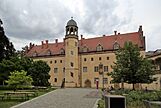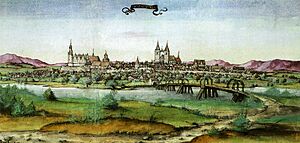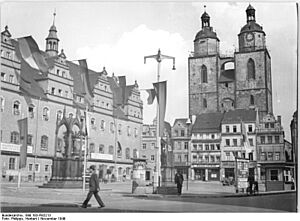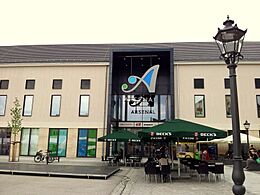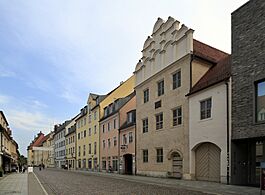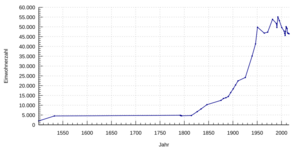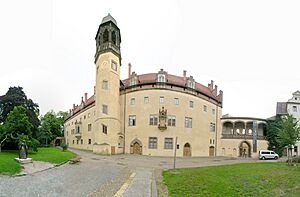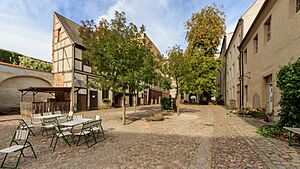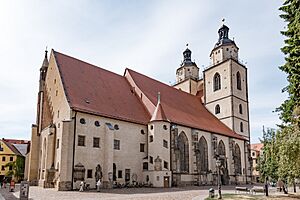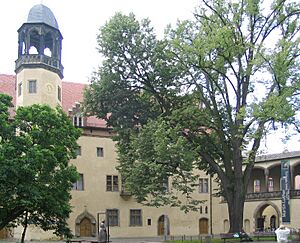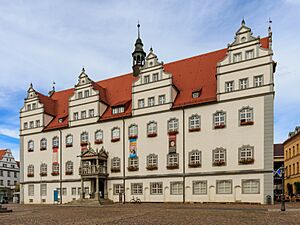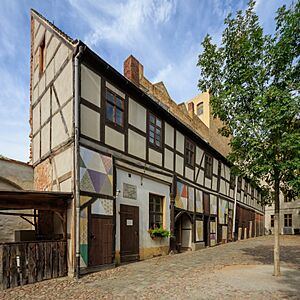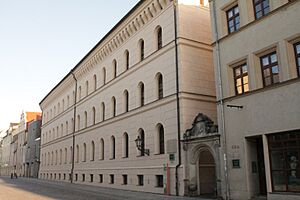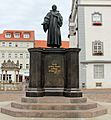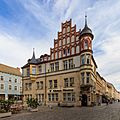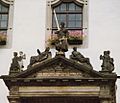Wittenberg facts for kids
Quick facts for kids
Wittenberg
Lutherstadt Wittenberg
|
||
|---|---|---|
|
View of Wittenberg
Schlosskirche
Stadtkirche
Theses Doors
Lutherhaus
|
||
|
||
|
Location of Wittenberg within Wittenberg district
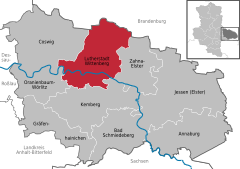 |
||
| Lua error in Module:Location_map at line 530: Unable to find the specified location map definition: "Module:Location map/data/Germany Sachsen-Anhalt" does not exist. | ||
| Country | Germany | |
| State | Saxony-Anhalt | |
| District | Wittenberg | |
| Area | ||
| • Total | 240.41 km2 (92.82 sq mi) | |
| Elevation | 67 m (220 ft) | |
| Population
(2022-12-31)
|
||
| • Total | 45,535 | |
| • Density | 189.406/km2 (490.558/sq mi) | |
| Time zone | UTC+01:00 (CET) | |
| • Summer (DST) | UTC+02:00 (CEST) | |
| Postal codes |
06886
|
|
| Dialling codes | 03491 | |
| Vehicle registration | WB | |
| Website | wittenberg.de | |
Wittenberg, officially called Lutherstadt Wittenberg, is a town in Germany. It is the fourth-largest town in the state of Saxony-Anhalt. Wittenberg is located on the River Elbe, about 60 kilometers (37 miles) north of Leipzig and 90 kilometers (56 miles) southwest of Berlin. In 2018, it had a population of 46,008 people.
Wittenberg is famous for its strong connections to Martin Luther (1483–1546). He was a key figure in the Reformation, a big religious movement in the 16th century. This movement led to the start of Protestantism and Lutheranism. Because of this, Wittenberg is known as the "cradle of the Reformation." Many buildings in the town are linked to these important historical events. For example, part of the Augustinian monastery where Luther lived is still there.
Wittenberg was also an important political center. It was the home of the prince Elector of Saxony. This made it one of the most powerful cities in the Holy Roman Empire for many years.
Today, Wittenberg is a place for industry and tourism. It has a well-preserved historic center and many sites dedicated to Martin Luther and his friend Philipp Melanchthon. These buildings were added to the UNESCO World Heritage Site list in 1996. They are recognized for their religious importance and their role in one of the most influential movements in world history.
Contents
History of Wittenberg
![]() Duchy of Saxony 1180–1296
Duchy of Saxony 1180–1296
![]() Duchy of Saxe-Wittenberg 1296–1356
Duchy of Saxe-Wittenberg 1296–1356
![]() Electorate of Saxony 1356–1806
Electorate of Saxony 1356–1806
![]() Kingdom of Saxony 1806–1815
Kingdom of Saxony 1806–1815
![]() Kingdom of Prussia 1815–1871
Kingdom of Prussia 1815–1871
![]() German Empire 1871–1918
German Empire 1871–1918
![]() Weimar Republic 1918–1933
Weimar Republic 1918–1933
![]() Nazi Germany 1933–1945
Nazi Germany 1933–1945
![]() Soviet occupation zone 1945–1949
Soviet occupation zone 1945–1949
![]() East Germany 1949–1990
East Germany 1949–1990
![]() Germany 1990–present
Germany 1990–present
| UNESCO World Heritage Site | |
|---|---|
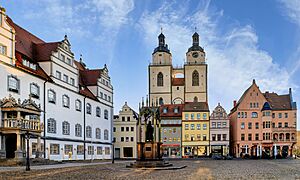
Market square with Stadtkirche Wittenberg
|
|
| Part of | Luther Memorials in Eisleben and Wittenberg |
| Includes | Lutherhaus, Melanchthonhaus, Stadtkirche Wittenberg and All Saints' Church, Wittenberg |
| Criteria | Cultural: iv, vi |
| Inscription | 1996 (20th Session) |
Wittenberg was first mentioned in historical records in 1180. It started as a small village founded by people from Flanders. In 1260, it became the home of the dukes of Saxe-Wittenberg. The town officially received its town charter in 1293.
Over the next few centuries, Wittenberg grew into an important trading center. This was because of its central location. In 1422, the House of Wettin took control of Saxe-Wittenberg. The town became a major political and cultural hub in the late 1400s. This happened when Frederick III "the Wise", who was the Elector of Saxony, made Wittenberg his home.
The University and the Reformation
In 1502, Elector Frederick founded the University of Wittenberg. This university attracted important thinkers like Martin Luther. Luther became a theology professor there in 1508. His friend and fellow reformer, Philipp Melanchthon, also became a professor of Greek in 1518.
A famous story says that on October 31, 1517, Luther nailed his "95 Theses" to the doors of the Castle Church. These theses were a challenge to the practice of selling indulgences. This event is often seen as the start of the Protestant Reformation. Luther later translated the Bible into German so that more people could read it.
Wars and Changes
In 1547, the Capitulation of Wittenberg was a treaty that changed who ruled Saxony. Later, in 1760, during the Seven Years' War, Austrian forces attacked the town.
Wittenberg was also involved in the Napoleonic Wars. French forces took control in 1806. In 1813, Napoleon Bonaparte ordered the town's defenses to be strengthened. However, in 1814, the Prussian Army stormed Wittenberg. After these wars, Wittenberg became part of the Kingdom of Prussia.
During World War I, a prisoner-of-war camp was set up outside Wittenberg. It held soldiers from various Allied nations. Conditions were difficult, especially during a typhus outbreak.
Unlike many other German cities, Wittenberg's town center was mostly saved during World War II. However, a factory near Wittenberg that made airplane parts for the German air force was bombed by Allied planes.
After World War II, Soviet forces occupied Wittenberg. It became part of East Germany in 1949. After the peaceful revolution in 1989, East Germany dissolved. Wittenberg has been part of a united Germany since 1990.
Modern Wittenberg
Today, Wittenberg is undergoing many changes. Old buildings are being renovated, and new ones are being built. The town is focusing on tourism, especially as a "place of pilgrimage for the Reformation." From 2008, the town prepared for the 500th anniversary of the Reformation in 2017. Many buildings were restored, and new attractions were created.
In 2014, Lutherstadt Wittenberg was named an European City of the Reformation.
Historical Population
The population of Wittenberg has changed a lot over the centuries. Here's a look at how many people lived in the town at different times:
- 1500: 2,000
- 1532: 4,500
- 1791: 4,860
- 1814: 4,727
- 1846: 10,283
- 1880: 13,448
- 1900: 18,345
- 1925: 24,160
- 1939: 35,130
- 1950: 49,852
- 1971: 47,323
- 1989: 51,754
- 2000: 49,643
- 2013: 46,729
Town Divisions
Wittenberg includes the main town and several smaller municipal divisions, called Ortschaften. These include:
- Abtsdorf
- Apollensdorf
- Boßdorf
- Griebo
- Kropstädt
- Mochau
- Nudersdorf
- Pratau
- Reinsdorf
- Schmilkendorf
- Seegrehna
- Straach
Climate and Weather
Wittenberg has a typical oceanic climate. This means it has cool winters and warm summers. The average temperature ranges from 1°C (34°F) in winter to 19°C (66°F) in summer. Summer temperatures, from May to September, are usually above 10°C (50°F).
The town experiences about 14 days each year where temperatures go above 30°C (86°F). In winter, there are about 18 days when the highest temperature stays below freezing. The earliest snowfall recorded was on October 30, 1940, and the latest was on April 29, 1985.
Sights and Culture
Wittenberg offers many cultural and historical sites. Most of these are found in the old town along the "Wittenberg Culture Mile."
Churches
Schlosskirche (Castle Church)
The Schlosskirche, or Castle Church, is one of Wittenberg's most famous landmarks. It is especially known as the place where Martin Luther supposedly posted his 95 Theses. These theses challenged the practices of the Roman Catholic Church. The church was rebuilt between 1883 and 1892 to highlight its historical importance. In 2017, it was extensively renovated for the 500th anniversary of the Reformation.
Inside the church, you can find the tombs of Martin Luther and Philipp Melanchthon. There are also portraits of the reformers by Lucas Cranach the Younger.
Stadtkirche (Town Church)
St. Mary's Town Church is known as the "mother church of the Reformation." Martin Luther often preached here. The first Protestant service was held here in 1521. The church has beautiful artworks by Lucas Cranach the Elder and Lucas Cranach the Younger.
Other Churches
- Unbefleckte Empfängnis Catholic Church: This church on Mauerstraße was built in 1872 and renovated in 1999/2000.
- Christ Church: Built in 1907/1908, this church is located in the Kleinwittenberg area.
Other Important Buildings
- Augusteum and Luther House: The Augusteum was once part of the University of Wittenberg. Inside its courtyard is Martin Luther's former home, now a museum. It displays pictures, writings, and items from the Reformation era.
- Melanchthon House: This house was where the reformer Philipp Melanchthon lived and died. It now holds an exhibition about his life.
- University Leucorea Wittenberg: Founded in 1502, this university was where Martin Luther and Melanchthon taught.
- Bugenhagenhaus: Next to the town church, this is the oldest Protestant vicarage (pastor's home) in the world. Johannes Bugenhagen, a close friend of Luther, was the first pastor to live here. Today, it's a community and meeting center.
- Stadthaus: This modern building complex on Arsenalplatz includes parts of a medieval Franciscan monastery. It now serves as a visitor center, event space, and archive.
- Altes Rathaus (Old Town Hall) and Marktplatz (Market Square): The market square is in the center of the old town. It features the Renaissance town hall and statues of Martin Luther and Philipp Melanchthon.
- Cranach-Höfe (Cranach Courtyards): These courtyards show the work of the famous Cranach family of artists. Lucas Cranach the Elder had his print shop here, where many important Reformation texts, including parts of Luther's Bible, were printed. You can see a historical Gutenberg press here.
- Wittenberg Castle: This was once the home of the Saxon Electors. After being damaged in wars, it was used as a barracks. Today, it serves civilian purposes.
Museums to Explore
- Cranach-Höfe, Markt 4: Features changing art exhibitions.
- Altes Rathaus (Old Town Hall): Also hosts changing exhibitions.
- Christian Art Foundation Wittenberg: Located in Wittenberg Castle, it has a permanent exhibition and special shows.
- Haus der Geschichte: Shows housing culture of the 20th century, especially from former East Germany.
- Museum of Municipal Collections in the Zeughaus: Learn about the city's history and see natural history and ethnology collections.
- Science Center futurea, Markt 25: A modern science center.
Other Interesting Sights
- Luthereiche (Luther Oak): This oak tree marks the spot where Martin Luther famously burned the Pope's official letter in 1520. This act showed his break from the Roman Catholic Church.
- Röhrwasser: An old water supply system from the 16th century. It's the only working medieval tube water system north of the Alps.
- Luthergarten: A park near the castle with 270 trees from all over the world.
- Panoramic circular image Luther 1517 by Yadegar Asisi: A huge panoramic artwork that shows Wittenberg in Luther's time.
- Tierpark Wittenberg (Zoological Garden): A local zoo.
- Alaris Butterfly Park: A park where you can see many different kinds of butterflies.
Wittenberg's Coat of Arms
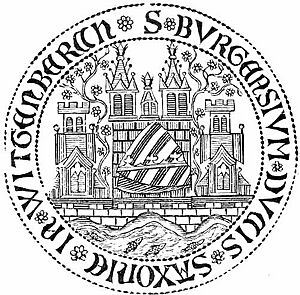
Wittenberg's coat of arms tells a story about the town's history. The town received its rights in 1293. The council, which governed the town, used its own seal. This seal, from the early 1300s, set the design for the town's coat of arms that we see today.
The coat of arms shows a wall with towers. This symbolizes that Wittenberg was a strongly fortified town by 1409. The two shields in the center represent the Electorate of Saxony. The right shield has gold and black stripes, which were the colors of the Ascanian rulers. The green "rue wreath" across it has been a symbol of Duke Albrecht II, the town's founder, since 1262.
The left shield shows crossed swords. This symbol stands for the important role of "Arch-Marshal of the Holy Roman Empire." This role was given to the Duke of Saxony-Wittenberg in 1356. The flowing water at the bottom of the shield represents Wittenberg's location on the River Elbe. The fish is a salmon, which used to be very common in the Elbe.
Economy and Transportation
Wittenberg is a center for the chemical industry. The SKW Stickstoffwerke Piesteritz GmbH is a large company here, with over 1,500 workers. Tourism is also very important, making Wittenberg a top destination in Saxony-Anhalt.
Lutherstadt Wittenberg station is the main railway station. It connects Wittenberg to Berlin in the north and Leipzig and Halle (Saale) in the south. The station was rebuilt to be more environmentally friendly and reopened in 2016.
Culture and Education
Wittenberg has a rich history of cultural events. Since 1996, the town has hosted outdoor theater shows about Luther's history. These shows attract many visitors.
Wittenberg is home to the Leucorea, which is part of the Martin Luther University of Halle-Wittenberg. This is the largest university in Saxony-Anhalt.
Famous People from Wittenberg
Many important people have lived in or been connected to Wittenberg. Besides Martin Luther and Philipp Melanchthon, others have left their mark.
From 1801 to 1900
- Friedrich Drake (1805–1882): A famous sculptor.
- Johann Gottfried Galle (1812–1910): An astronomer who helped discover the planet Neptune.
- Werner von Siemens (1816–1892): An industrialist who founded a major electrical engineering company.
- Otto Kleinschmidt (1870–1954): A natural scientist.
- Julius Riemer (1880–1958): Founded a museum in Wittenberg.
From 1901 to Today
- Erwin Wickert (1915–2008): A diplomat and writer.
- Konrad Wolf (1925–1982): A film director.
- Wolfgang Böhmer (born 1936): A medical doctor and former Minister President of Saxony-Anhalt.
- Reiner Haseloff (born 1954): A politician who has been the Minister-President of Saxony-Anhalt since 2011.
- Fernando Scarpa (born 1968): An Italian film director.
Sister Cities
Wittenberg is twinned with several cities around the world. These partnerships help promote cultural exchange and friendship.
 Göttingen, Germany (1988)
Göttingen, Germany (1988) Bretten, Germany (1990)
Bretten, Germany (1990) Springfield, Ohio, United States (1995)
Springfield, Ohio, United States (1995) Békéscsaba, Hungary (1999)
Békéscsaba, Hungary (1999) Haderslev, Denmark (2004)
Haderslev, Denmark (2004) Beveren, Belgium (2019)
Beveren, Belgium (2019) Mediaș, Romania (2019)
Mediaș, Romania (2019) Mogilev, Belarus (2019)
Mogilev, Belarus (2019)
Images for kids
-
Replica of the Ninety-five Theses in the All Saints' Church
-
Hundertwasserschule, School by Friedensreich Hundertwasser
-
Philipp Melanchthon in the market square
See also
 In Spanish: Wittenberg para niños
In Spanish: Wittenberg para niños






